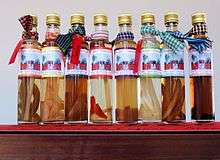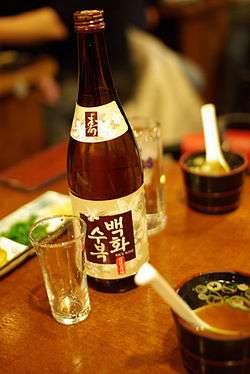Rice wine
Rice wine, also known as mijiu, is an alcoholic drink made from rice, traditionally consumed in East Asia, Southeast Asia, and South Asia. Rice wine is made from the fermentation of rice starch that has been converted to sugars. Microbes are the source of the enzymes that convert the starches to sugar.[1]
Rice wine typically has an alcohol content of 18%–25% ABV. Rice wines are used in Asian gastronomy at formal dinners and banquets and in cooking. They are also used in a religious and ceremonial context.
Types

A bottle of Tapuy, a Philippine rice wine.

Bottles of Sombai (Cambodian infused rice wine / liqueur).
Some types of rice wine are:
- Apong - An Indian rice wine indigenous to the Mising tribe, from the Northeastern states of Assam and Arunachal Pradesh.
- Ang Jiu - Chinese red rice wine, popular among the Fujian Chinese (Malaysia, China). The red color is derived from iron in the red yeast rice, the traditional yeast culture made from wild yeast in the city of Fuzhou, where this style of rice wine originated, and the ancestral origin of many overseas Chinese in the Pacific islands.
- Ara - Bhutanese rice, millet, or maize wine
- Brem - Balinese rice wine
- Cheongju - Korean rice wine
- Beopju - a variety of cheongju
- Cholai - A reddish rice wine from West Bengal, India
- Choujiu - A milky glutinous rice wine popular in Xi'an, China
- Gamju - A milky, sweet rice wine from Korea
- Hariya -A white/watery rice wine from India.
- Huangjiu - A Chinese fermented rice wine, literally "yellow wine" or "yellow liquor", with colors varying from clear to brown or brownish red.
- Ju Mai - An Indian local rice alcohol indigenous to the Boro tribe of the Northeastern State of Assam.
- Kulapo - A reddish rice wine with strong odor and alcohol content from the Philippines
- Lao-Lao - A clear rice wine from Laos
- Lihing - Kadazan-Dusun rice wine from Sabah, Malaysian Borneo
- Luk Lao - rice wine of the Tai Ahoms of Assam. Which can be preserved for years. It attains red color when aged (around 6 months).
- Makgeolli - a milky traditional rice wine indigenous to Korea.
- Mijiu - a clear, sweet Chinese rice wine/liqueur made from fermented glutinous rice.
- Mirin - a Japanese rice wine used in cooking.
- Pangasi - Rice wine from Mindanao in the Philippines.
- Chhyang - Tibetan and Sherpa rice wine
- Rohi - A sweet, white type of rice alcohol, commonly made by the Sonowal Kachari tribe belonging to the Northeastern Indian state of Assam. Mostly consumed during festivities and family gatherings.
- Rượu cần - Vietnamese rice wine drunk through long, thin bamboo tubes
- Sake - A rice wine from Japan. The most widely known type of rice wine in North America because of its ubiquitous appearance in Japanese restaurants.
- Sato - A rice wine originating in the Isan region of Thailand
- Shaoxing - A rice wine from Shaoxing, Zhejiang province, China, probably the best known Chinese rice wine
- Sombai - Cambodian infused rice wine with sugar cane, fruits and spices still inside the bottle
- Sonti - Indian rice wine
- Tapai - Kadazan-Dusun rice wine from Sabah, Malaysian Borneo
- Tapuy - Clear rice wine from the Mountain Province in the Philippines
- Thi- Kayan rice wine,served in a clay-pot with a straw to sip (Kayah State, Myanmar).
- Tuak - Dayak rice wine (Kalimantan (Indonesian Borneo); Sarawak (Malaysian Borneo)
- Xaaz - A Indian local white rice alcohol from the Northeastern state of Assam, predominantly in the rural households of the districts of Upper Assam. Consumed mostly during the harvesting and New Year festival of Bihu in the months of January and April respectively.
- Yu (Sekmai Yu, Andro Yu, Phayeng Yu and other variants) - A transparent rice wine from Manipur
- Zoujiu - Rongmei naga (Manipur, Assam, Nagaland) traditional drink it's a rice wine, made from fermented boiled rice mixed with leaven made from new buds of rice
- Zoungao -Rongmei naga traditional rice milky beer, made from rice floor without yeast
See also
References
- ↑ Huang, H. T. "Science and civilization in China. Volume 6. Biology and biological technology. Part V: fermentations and food science." (2000).
Further reading
- Campbell-Platt, Geoffrey (2009). Food Science and Technology. John Wiley & Sons. pp. 86–91.
This article is issued from
Wikipedia.
The text is licensed under Creative Commons - Attribution - Sharealike.
Additional terms may apply for the media files.



